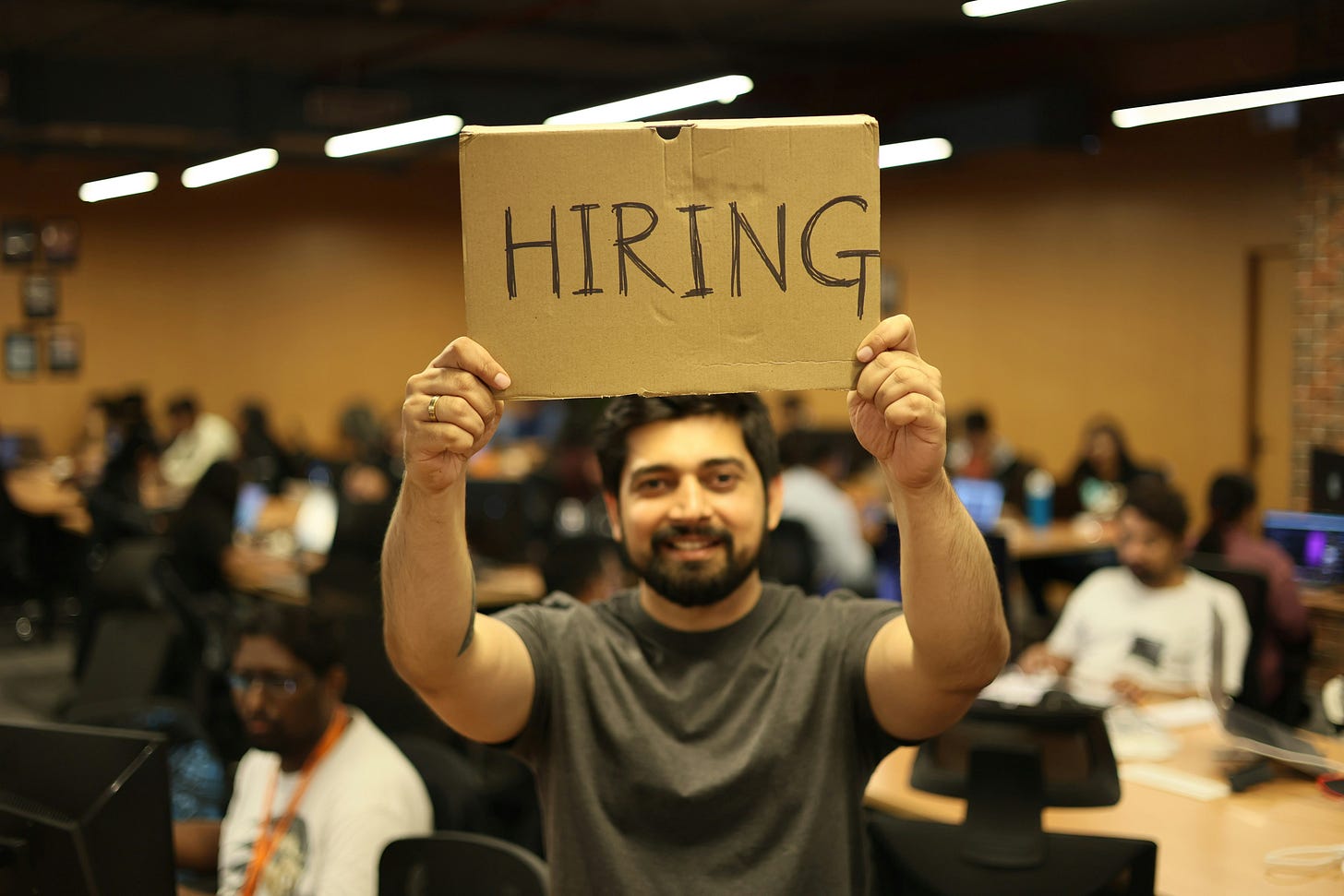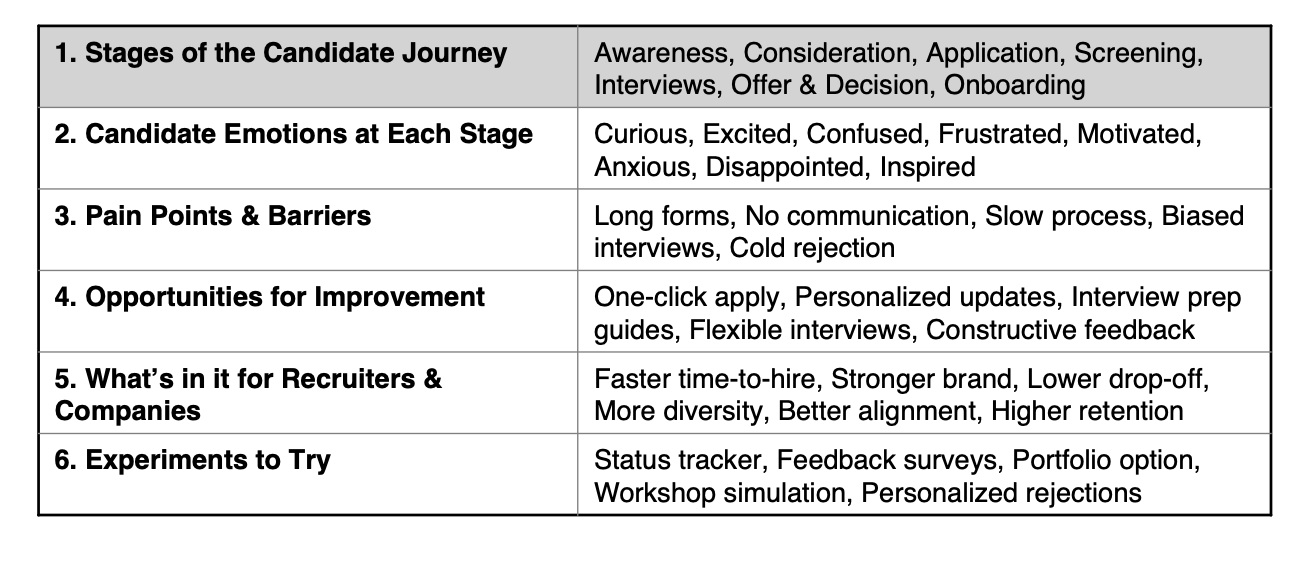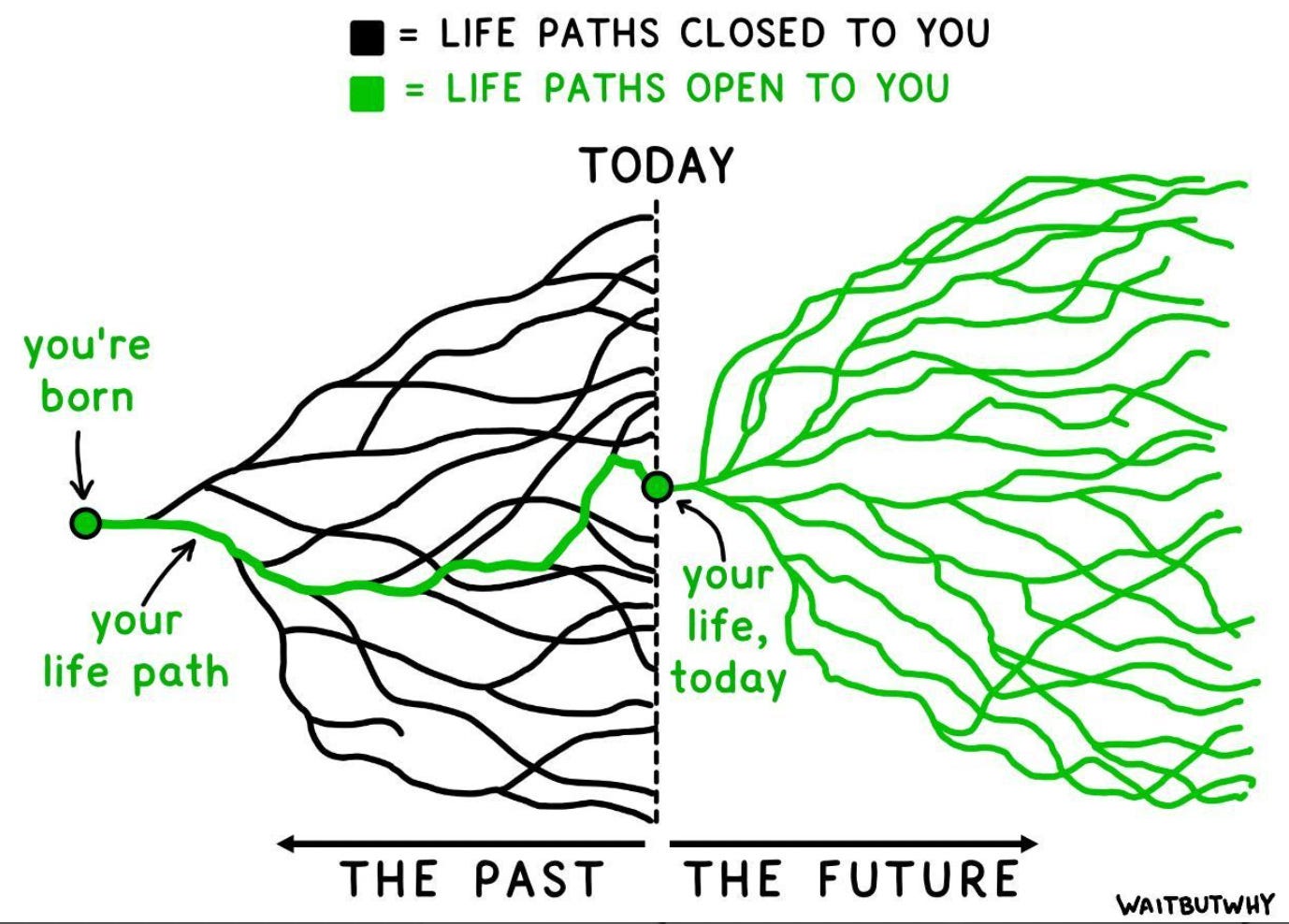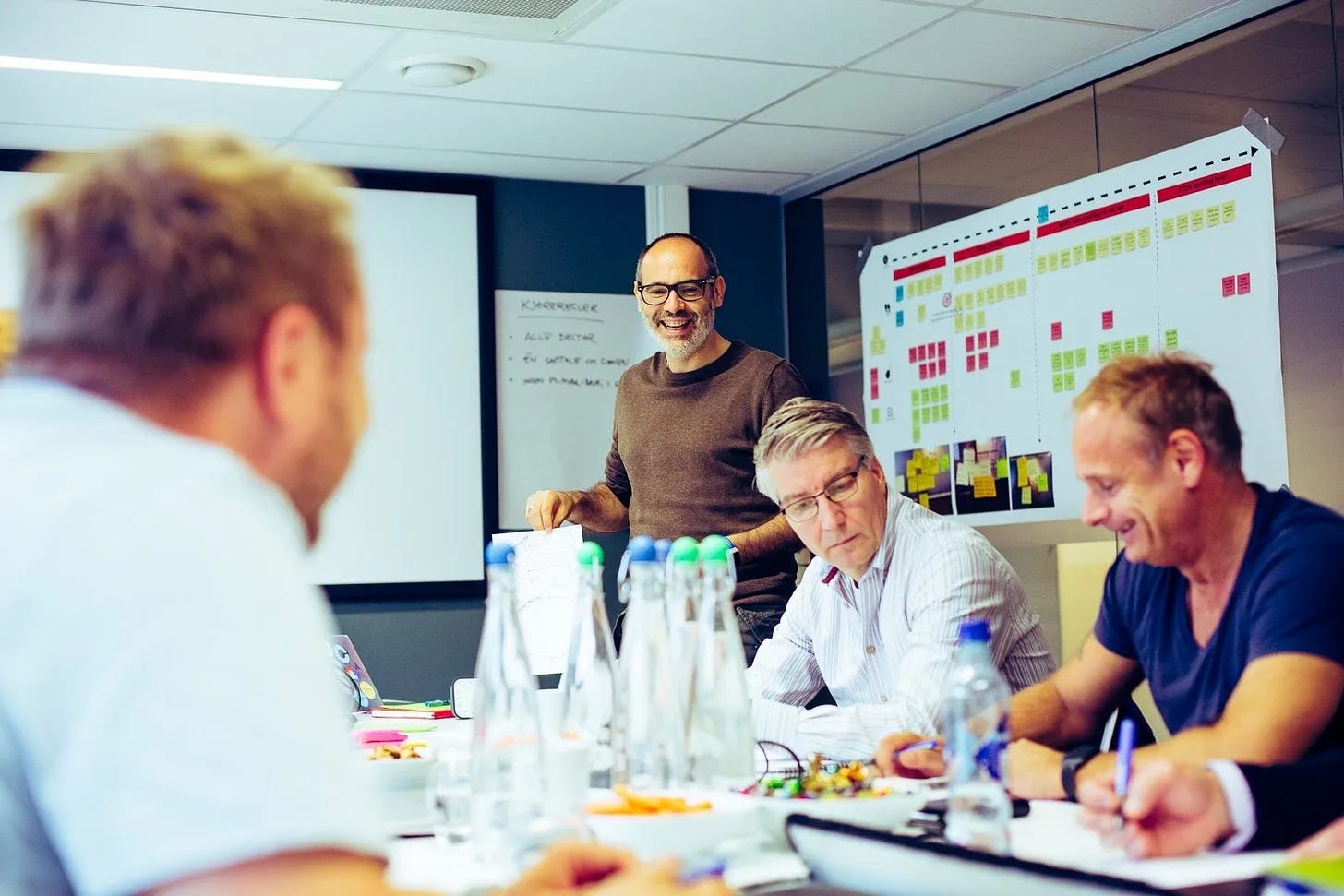Rethinking the Candidate Journey: Why Experience Matters More Than Ever
How better hiring experiences attract top talent, strengthen your brand, and save you money

Let’s face it, most hiring processes are still stuck in the past.
Endless forms, black-hole application portals, ghosting, unclear expectations, and slow feedback loops. And then we wonder why talented people drop out halfway through or never apply again.
If we want to attract great people, we must design better experiences.
The candidate journey is a service journey and like any other service, it can (and should) be designed with the user in mind.
But Why Should Recruiters and Companies Care?
Bad candidate experiences aren’t just an HR inconvenience. They come with real, measurable costs:
Drop-off of top talent: The best candidates don’t wait around. A clunky, slow, or unclear process means they’ll accept offers elsewhere.
Reputation damage: Candidates talk. They share their experiences on Glassdoor, LinkedIn, or with friends. Negative word-of-mouth directly impacts your employer brand—and even your consumer brand if you’re a B2C company.
Higher hiring costs: A poor process increases time-to-hire, requiring more advertising, agency fees, and recruiter hours.
Lost productivity: Vacant roles mean teams are stretched thin. Every week without the right hire costs time, energy, and money.
Lower diversity & inclusion: Complex or biased processes filter out diverse talent. The result? Homogenous teams that lack the innovation edge diverse perspectives bring.
The Benefits of a Great Candidate Experience
On the flip side, companies that invest in candidate experience see clear payoffs:
Faster hiring cycles: Candidates move smoothly from application to offer, reducing delays and competition loss.
Stronger employer brand: Every candidate becomes a brand ambassador, even if they don’t get the job. A good experience builds trust and respect.
Attraction of top talent: The best people want to work for organizations that treat them well. A seamless process is itself a recruiting tool.
Better quality hires: A respectful, well-designed process attracts candidates who are more engaged and aligned with your culture.
📈 Retention boost: Employees who start with a positive hiring journey often stay longer—they already feel valued.
💡 Strategic edge: In industries fighting for scarce talent, candidate experience is a competitive differentiator.
Here’s how we can start innovating.
Map the Journey (Then Walk It Yourself)
Most hiring managers haven’t applied to their own companies. Try it. Go through your own process. See where it gets confusing, boring, slow, or unfair.
Use journey maps to visualize the steps, the emotions, and the pain points. Involve recruiters, hiring managers and even recent candidates to get the full picture.
Communicate Like a Human (Not a System)
Silence is louder than you think. A candidate who hears nothing for 3 weeks might assume they’ve been rejected and lose interest.
Make every interaction count:
Acknowledge every application.
Provide realistic timelines.
Share honest updates.
Be personal where you can.
(Yes, automation can help, but only if it feels human, not robotic.)
Remove the Noise from the Application
Nobody wants to spend 45 minutes rewriting their CV into a clunky form.
Allow “one-click” applications (e.g. via LinkedIn).
Only ask for what you really need.
Let the candidate shine with a short intro video or task, if it adds value to both sides.
Ask yourself: Are we collecting information, or creating value?
Respect Their Time, Attention, and Energy
Interviews should be a two-way street, not a one-sided interrogation.
Standardize the process for fairness, but make it personal enough to connect.
Ensure diverse and inclusive interview panels.
Offer flexibility—virtual, async, in-person, depending on what makes sense.
A good interview doesn’t just assess; it attracts.
Give Feedback, Even When It’s a No
Rejection sucks. But silence is worse.
Offer simple, constructive feedback, ideally within a week.
If a candidate isn’t right now, but could be later, tell them.
Invite them to join a talent pool or community for future roles.
Feedback turns a bad experience into a useful one. And often, people reapply if they’ve been treated with dignity the first time.
Innovate with Small Experiments
Innovation doesn’t have to mean AI bots or VR assessments (though those can be cool). Start small:
Add a progress bar to your application portal.
Replace one interview with a problem-solving workshop.
Let candidates choose between a traditional CV or a project portfolio.
Design the experience like you would any other service. Prototype, test, iterate.
Candidate Journey Canvas
Use this canvas to map and redesign your hiring process. The goal: identify friction points, opportunities for innovation, and ways to create a more human, engaging experience.
1. Stages of the Candidate Journey
Break the process into clear steps:
Awareness (how candidates discover you)
Consideration (researching your company, deciding to apply)
Application (submitting documents/forms)
Screening (resume review, assessments)
Interviews (first, second, final rounds)
Offer & Decision (receiving, negotiating, accepting/declining)
Onboarding (first days/weeks as employee)
2. Candidate Emotions at Each Stage
Map the emotional journey:
Curious? Excited?
Confused? Frustrated?
Motivated? Anxious?
Disappointed? Inspired?
3. Pain Points & Barriers
Identify what makes the journey harder:
Long, repetitive forms
No communication or feedback
Slow process, unclear timelines
Biased or inconsistent interviews
Cold rejection with no closure
4. Opportunities for Improvement
Brainstorm solutions:
One-click apply / simplified forms
Automated but personal updates
Interview prep guides or FAQs
Flexible interview formats (virtual, async, in-person)
Constructive rejection feedback
5. What’s in it for Recruiters & Companies
For each improvement, list the value created:
Faster time-to-hire
Stronger employer brand
Lower drop-off of top talent
More diverse candidate pool
Better cultural alignment
Longer retention rates
6. Experiments to Try
Small, low-risk ways to test improvements:
Add a “status tracker” to your portal
Pilot candidate feedback surveys
Offer candidates choice between CV upload or portfolio submission
Replace a panel interview with a workshop simulation
Send personalized rejection notes
In Summary: Treat Candidates as People, Not Just Inputs
The goal is not just to fill vacancies. The goal is to create meaningful connections between people and opportunities.
The best talent looks at how you treat them before they join.
That experience speaks louder than your employer brand video.
So…. what’s the candidate journey like in your organization?
Is it a joy to walk through…
…or something people survive and warn their friends about?
💡 At Facili-station, I regularly share tools and reflections for facilitators, designers, and leaders who want to make things easier and more human. Want more on service design in HR? Subscribe or reach out. Let’s keep improving the world of work, one experience at a time.
I hope this post, made sense and you found it useful.
If “HELL YEAH!”, please like it and share it in social media so more people can get can also benefit from it :-)
I would also appreciate if you subscribe, and give some comments here if you wonder something and want to give me some feedback. I would love to read your input here!
If you have a Substack yourself and like my content, I would love for you to recommend “Facili-station” to your subscribers.
Have a nice one!!
Looking for a coach?
In service of those who serve others.
Leadership is hard. Whether you’re stepping into management, leading an entire organization or wondering about your career, the challenges are real: confusing, overwhelming, and sometimes isolating.
I offer a tailored 1:1 or team coaching quarterly program to help you move forward with clarity and confidence. I’ve walked in your shoes, and I’ll work with you to build the resilience and relational skills needed to lead well, beyond just the work.
If this sounds like what you need, let’s talk. Email me at jose@facilistation.com to book a no-strings attached, no-obligation call to talk about your needs and see what I can offer that will fit you the best. Because coaching isn’t expensive. Staying stuck is.
You should see the cost of a life and work that you don’t love... sometimes one good conversation can change your life and your career forever.
Looking for a facilitator and workshop designer?
If you need a workshop designer and facilitator to help you or your team to solve challenges, find solutions, make decisions, and to be more effective an perform better and faster, or a trainer to teach your team on how do this, please contact me at jose@facilistation.com
My workshops are designed to provide the structure required to quickly align and move forward with a plan or idea so you can reclaim time, energy and headspace.






Wow, the point about lower diversity and inclusion really resonated. You're so right that bad candidate experiences come with real, measurable costs. It makes me wonder if ethical AI could truly optimize this service journey for both efficiency and fairnes. So much potential!